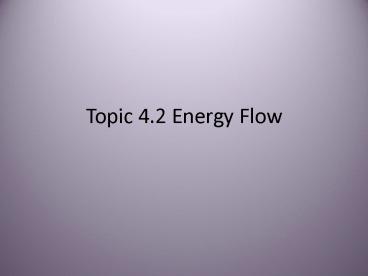Topic 4.2 Energy Flow - PowerPoint PPT Presentation
1 / 15
Title:
Topic 4.2 Energy Flow
Description:
Energy in Ecosystems Initial source of energy is the sun ... Primary consumers ... various energy conversions Light energy to chemical energy in ... – PowerPoint PPT presentation
Number of Views:145
Avg rating:3.0/5.0
Title: Topic 4.2 Energy Flow
1
Topic 4.2 Energy Flow
2
QOD
- Why did the hippy girl say that all humans should
be vegetarians?
3
Energy in Ecosystems
- Initial source of energy is the sun (in most
ecosystems) photosynthesis - Deep ocean trenches rely on chemosynthesis
4
Energy in Food Chains
- Chemical energy in carbon compounds flow through
food chains by means of feeding - Food chains show direct flow of energy from one
feeding level to the next - Each feeding level is called a trophic level
- Arrows drawn in food webs represent the direction
of energy transfer - Most of the energy consumed is lost
5
Food Chain
- 10 if ingested food is converted to new organic
molecules - 3-5 organisms in each food chain
6
Food Webs
- Collection of food chains
- Many organisms feed on a variety of things
- Complex feeding interactions
7
Trophic Levels
- A feeding level in a food chain or food web
- Represent organisms position in the food
chain/web - Trophic levels include the following
- Producers (autotrophs)
- Primary consumers (herbivores)
- Secondary consumers (omnivores or carnivores)
- Tertiary consumers (omnivores or carnivores)
8
What eats what
- Herbivores eat only plants
- Omnivores eat both plants and meat
- Carnivores eat meat
9
Pyramid of energy
10
Biomass
- The total mass of a group of organisms
- Biomass decreases at each trophic level
- Reasons for this trend
- Most of the energy in food that is digested and
absorbed by organisms in a trophic level is
released by them in respiration for use in cell
activities. So only chemical energy is available
at the next level - Organisms in trophic levels are not usually
entirely consumed - Not all parts of food ingested by organisms are
digested and absorbed - Biomass diminishes due to loss of CO2, H20, and
other waste products(urea)
11
Respiration Energy Release
- Energy released by respiration is used in living
organisms and converted to heat - Living organisms need energy for the following
- Synthesizing large molecules like DNA, RNA and
proteins - Pumping molecules or ions across membranes by
active transport - Moving things inside the cell, or muscles
- ATP supplies energy for these activities
12
ATP production
- ATP produced by cellular respiration
- Carbon compounds are oxidized
- This is exothermic and energy is released, this
is used in endothermic reactions to make ATP - Cell respiration transfers chemical energy from
glucose to ATP
13
2nd law of Thermodynamics
- Energy transformations are never 100 efficient
- Not all is transferred to ATP the rest becomes
heat.
14
Heat Energy in Ecosystems
- Living organisms cannot convert heat to other
forms of energy - Perform various energy conversions
- Light energy to chemical energy in photosynthesis
- Chemical energy to kinetic energy in muscle
contractions - Chemical energy to electrical energy in nerve
cells - Chemical energy to heat energy in heat-generating
adipose tissue
15
Heat losses from Ecosystems
- Heat passes from hotter to cooler bodies
- Heat produced in living things is all eventually
lost to the abiotic environment - Heat may remain for a while but will ultimately
be lost































